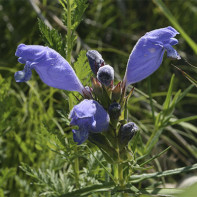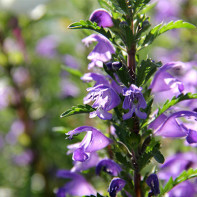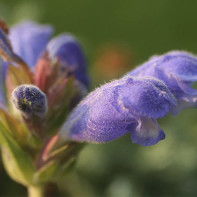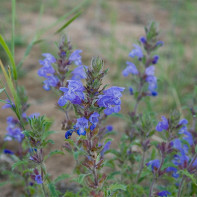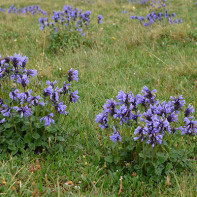Snakehead: medicinal properties and contraindications
An unpretentious herbaceous plant with textured flowers, similar to the head of a snake or dragon with an open mouth, can be found in many countries of the world. The snakehead is an excellent honey plant, valued by herbalists for its medicinal properties, cosmetologists for its delicate aroma, and culinary specialists for its spicy flavor.
- How it looks and where it grows
- Kinds
- Collection and storage
- Chemical composition
- The healing properties of the snakehead
- Moldavian snakehead in folk medicine: recipes
- Infusion
- Decoction
- Healing tea
- Vitamin drink
- Tincture for hypertensive crises
- Compress
- Inhalation
- Bath
- Massage Oil
- The use of grass snakehead
- Cookery
- Cosmetology
- Contraindications
- Snakehead on its own garden
How it looks and where it grows
The plant is low, barely reaches 60–70 cm. The stem is straight and dense, tapering from the base to the crown. There are formed inflorescences of purple or blue hue. White flowers are rare.

The name is compound, comes from the merger of the two Latin words “dragon” and “head”. But he has much more popular nicknames. They reflect properties or appearance. So in different areas and countries there are names:
- honey cake;
- turkish mint;
- bruise;
- mother liquor;
- dragon head.
It is about the same plant. Another thing is that there are several varieties of it, slightly different in appearance. Some of them are purposefully bred as medicinal or garden decorative. Despite the differences in the appearance of the leaves and the size of the plant itself, the flowers are very similar in shape and resemble the head of a hissing snake or dragon. The sowing seed-nut is also similar to a mythical beast, because it has an elongated shape and two bright spots that resemble the eyes.
Kinds
All varieties belong to the family Lamiaceae, unpretentious to the conditions of growth. They count a little more than 40 species. For all, the flowering time falls on the interval from the first of July to the end of August, in September seeds are already forming.
Interesting: the plant blooms in tiers, starting from the bottom and is able to form up to 500 flowers per season.
The most famous and sought after are 6 species.
- Moldavian is very unpretentious. It tolerates drought, waterlogging and severe frosts. The most unpretentious species, found in many countries, prefers to settle along the shores of water bodies. It differs from other species in an extended flowering period. The first buds appear in mid-July and continue to delight in flowers almost to frost.
- Drooping is common in areas of Siberia, the Volga region, the Black Sea regions, in the Far East. The opened flowers of a delicate purple hue, blooming, acquire a blue color. Lives 1-2 years depending on the habitat. In folk medicine, all parts of the plant that have a strong soothing effect are used.
- Timyanotsvetkovy recognize by early flowering. He opens a cup of inflorescences already in early spring, in the middle of summer ripened trihedral dark seeds. On the stem, tiers are clearly expressed, where flowers are located in leaf rosettes. Most often found in the Caucasus and Kazakhstan. Sometimes it can be found near the dwelling and along the roads, there it appears like an alien, in a normal environment, preferring wet troughs.
- Ruysha perennial, the highest of all members of the family. Bright blue flowers of characteristic shape are visible from afar. Prefers rocky slopes, steppe expanses, foothills. It is found in the Caucasus, in Central Asia, in the middle zone of Russia. It is often used as an ornamental plant, given its ability to attract bees and at the same time frighten off the spicy aroma of pests.
- Alien in Russia is found only in Siberia. The main growing region is China, Mongolia. It features a powerful, well-developed root. Plant height varies depending on living conditions. Willingly grows on rocky soil.In folk medicine, it shows duality. Different concentration of the infusion depresses or excites the nervous system, so the herbal infusion is used strictly according to the instructions.
- Large-flowered or Altai is characterized by beautiful bright blue flowers. Perennial, prefers moist, loose soils rich in minerals. Refers to honey plants, has a strong lemon smell.
The habitat of the snakehead is very wide - from Central Asia and China to Siberian open spaces. Despite the differences in appearance and lifespan, all varieties have medicinal properties, scare away the strong smell of garden and garden pests. In folk recipes, the entire terrestrial part of the plants is used.
The snakehead has been adapted for cultivation. For these purposes varieties are derived:
- Albion;
- Egoist;
- Gorynych;
- Aroma 1 and 2;
- Gorgon.
They are larger than wild ones and have a more pronounced smell of flowers and leaves.
Collection and storage
The most valuable raw materials are obtained by collecting at the very beginning of flowering. To do this, choose a dry sunny day, cut off the upper part of the plant by about 1/3 or a little more, along with leaves and flowers. Sometimes for complex mixtures take raw materials without a stem, collecting it manually. For each species, the time of bud formation is slightly different, you need to navigate to the beginning of July. Only at thyme-flowering flowering occurs in the spring, which is necessarily taken into account when harvesting.
Dry the workpieces in a shady, well-ventilated place, without access to sunlight. For complete drying, it will take 2-3 days in good weather. The plant contains a lot of fatty acids and essential oils, which are valued in cosmetology, therefore, raw mass is processed during industrial harvesting. Moreover, this must be done as soon as possible after collection, so that the process of volatilization of light fractions does not begin.
Chemical composition
It may vary slightly in detail, depending on the type and place of growth. Common elements of all varieties are:
- tannins;
- coumarin;
- flavonoids;
- essential oils;
- fructose;
- glucose;
- glutamine and aspartic amino acids;
- magnesium;
- iron;
- zinc;
- potassium;
- alkaloids;
- oleic, linolenic, palmitic acid.
It is worth considering: useful substances are unevenly distributed in the plant, for example, the bulk of microelements is concentrated in the root system, and essential oils are in leaves and flowers.
The healing properties of the snakehead
Much depends on the type of plant, each of them has its own characteristics used in the treatment of diseases.
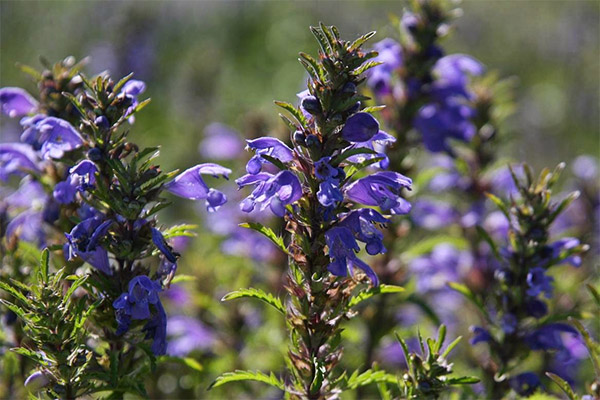
The Moldovan species is most often harvested. It has the broadest effect, is valued for its mild effect on most body systems, and is included in sedative, anticonvulsant, analgesic, anti-inflammatory drugs. The plant has a strong antibacterial, astringent and wound healing effect. It is used in the treatment of nasopharynx and throat, heart disease, sudden pressure surges with elevated rates, depressive states, loss of strength. Tinctures and decoctions based on the snakehead are effective for anemia, gastric diseases, and appetite disturbance.
An alien honey cake is planted to attract bees, used as a hemostatic and antitumor agent. Decoctions are prepared from it to alleviate the symptoms of gastritis, stabilize blood pressure, and normalize the emotional background. In the form of lotions, it is used to treat inflammation, acts as an antibacterial agent. It is very much appreciated in cosmetology for the abundance of essential oils and the ability to relieve skin irritations.
The dragon head Ruysch is grown as an ornamental plant. It is also cultivated on an industrial scale, using oil obtained from seeds in the paint and varnish industry. Drugs, which include leaves, flowers and the upper part of plants, are used to relieve headaches, strengthen potency, stabilize the digestive tract. The broth is effective during epidemics of influenza and respiratory diseases as a general strengthening and enhancing immunity. Compresses with tincture relieve pain with arthritis and rheumatism.
The thyme-flowered species has an antispasmodic and wound healing effect, is useful for vasospasm and intestinal colic. The broth quickly stops diarrhea, simultaneously having an antibacterial effect. Compresses relieve itching with scabies, stop its spread to other parts of the body.
The drooping mother liquor has a mild sedative effect. Also used as part of complex therapy for pulmonary tuberculosis, female diseases. Fees based on it relieve headaches, stop migraine attacks, increase the body's resistance during mass respiratory diseases. Broth baths are recommended for rheumatic pains. Infusion is used to rinse with gingivitis, stomatitis. It is taken orally according to the scheme for nephritis and gastroenteritis.
Large-flowered Turkish mint is effective for neuralgia, toothache, muscle and vascular spasms. It can be used as a mild laxative. Plant essential oil is able to quickly suppress the development of pathogenic fungi and have a preventive effect in case of an influenza epidemic and SARS. The peculiarity is that the pathogenic flora is not able to develop resistance to the snakehead. Appreciated as a spicy seasoning in preservation and confectionery.
Important: Altai species is considered one of the best honey plants, the honey is almost transparent, very fragrant, with a lemon smell. It retains the medicinal properties inherent in the plant.
Herbalists recommend collecting and harvesting each species separately, since they differ in their effects on the body and are effective in various diseases. The exception is general strengthening charges.
Moldavian snakehead in folk medicine: recipes
The plant is used in the preparation of decoctions, tinctures, for baths, compresses and lotions.
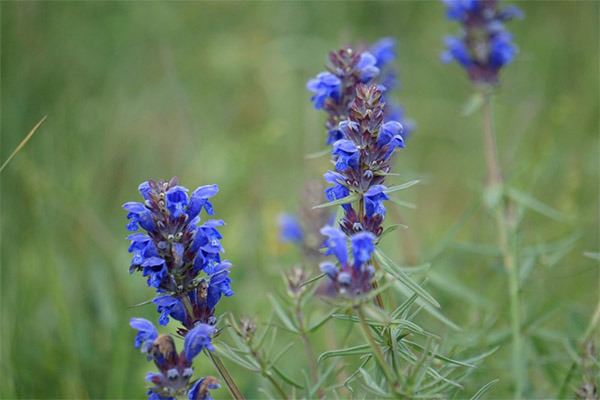
Infusion
It is prepared on an alcohol basis. You can replace it with vodka or double-brew moonshine. Proportions: 1 tbsp. spoon of dry raw materials per 200 ml of liquid. Insist 3-5 days in a dark place. Take 1 teaspoon with water. It is used for general weakness and gastrointestinal tract diseases.
Water infusion is effective for inflammation of the oral cavity, as lotions for wounds, bruises and skin inflammations. 1 tbsp. a spoon is brewed with a glass of boiling water, insisted for 15 minutes, taken half a glass three times a day for diseases of the stomach, kidneys, and genitourinary system. The infusion gives good results for migraines, colds, neuralgia.
Decoction
Effective for kidney disease. Prepared at the rate of 2 tbsp. tablespoons of leaves and flowers in 400 ml of water. They languish it in a water bath for 20 minutes, cool and filter.
Important: infusions and decoctions are not stored for more than 24 hours. Then they lose their healing properties.
Healing tea
It warms, soothes, relieves chronic fatigue and the effects of stress. It is used hot. A mixture of equal parts of the grass of the snakehead, oregano and mint, only 3 tbsp. spoon, pour boiling water and insist 10 minutes. Drink in any quantity instead of the usual afternoon drinks. Tea enhances immunity, it is recommended during menopause to relieve emotional outbursts.
Vitamin drink
For 1 liter of boiling water, take 2-3 tablespoons of honey, 150 ml of cranberry juice, 1 tbsp. a spoonful of honey of any kind. The grass is pre-insisted in boiling water for 2-5 minutes, then filtered. The rest of the ingredients are added to the infusion. It is best to prepare such a drink in batches, because it is drunk in a warm form. Cooling, it loses most of the aroma and beneficial properties.
Tincture for hypertensive crises
The tool helps to stabilize blood pressure and prevent its sharp increase against stress or as a reaction to weather changes. To prepare, take 0.5 cups of crushed root for 5 cups of vodka or diluted alcohol. The term for preparing the tincture is 15 days. Insist and store it in a cool dark place. Take a course of 30 days, 35-40 drops at night, washed down with water only. Mixing with milk, tea or compote is undesirable. In diluted form, tincture rubbed joints.
Compress
A thin lozenge is formed from the steamed grass and applied to the bruises.The compress is covered with a cotton cloth on top, but not insulated.
Inhalation
The antispasmodic and anti-inflammatory effect of the plant perfectly calms the cough, liquefies sputum, relieves spasm of blood vessels, facilitates breathing for most of the night. In a small enameled pan or ladle, place 2-3 tbsp. tablespoons of dried grass, pour boiling water at 2-3 cm. Inhalation is carried out 5-7 minutes before cooling the infusion. To increase the effect, you need to cover your head with a towel, creating a hut over the pan.
Bath
The procedure is useful for cystitis, diseases of the female genital area. It is carried out in a sitting position. It will take a bucket of boiling water and 200 g of dried leaves along with flowers. The grass is placed in boiling water and left until a comfortable temperature of 30-40 degrees is reached. Then the mixture is poured into the basin. A session lasts no more than 10 minutes.
Massage Oil
It is easy to cook at home. The base is any vegetable oil. The most commonly used olive cold pressed. A portion of fresh grass is poured with oil and cleaned in a cool dark place for 3 days. To better dissolve the nutrients, the container is shaken every day. Then the raw material is squeezed out, fresh part of the dried leaves is poured with the same oil. The procedure is repeated three times. After 9 days, the resulting oil can be used for massage.
The use of grass snakehead
The plant is considered quite common. He will not have to hunt for raw hollows, collecting pieces of precious stems by the piece. It grows whole clearings and in most cases it is simply mowed. This amount of raw material is enough for any purpose - medical, culinary, cosmetic. Bright lemon aroma and spicy taste allows you to use honey as an independent spice or use in aromatic gatherings along with pepper, cardamom, bay and currant leaves.
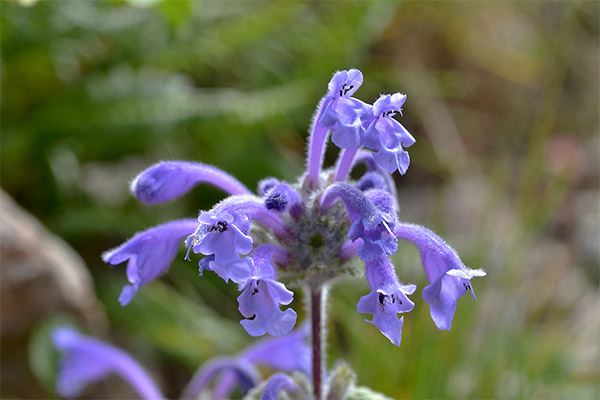
Cookery
The snakehead is not for nothing called Turkish melissa. It has a delicate but firm lemon flavor. And in the Altai variety, it is mixed with honey tones. The leaves are dried in a straightened state and stored for a year, adding to tea, fruit drink, fruit and berry compote. Fresh they are used in the preservation of cucumbers, tomatoes, watermelons, giving them a spicy aroma. Some sausages are also added a little honey, and this is already a recognized recipe.
The plant is added to mousse, jelly, fish broths, meat dishes, kvass. It is part of herbal mixes for the manufacture of vermouth, herbal balms and tinctures.
It is worth remembering: when boiled, the aroma and taste almost disappear, so the seasoning is put in an already prepared, but still hot dish.
The snakehead goes well with herbs and spices such as:
- fennel;
- anise;
- tarragon;
- mint;
- cloves;
- star anise;
- cinnamon;
- lovage.
With the addition of Turkish lemon balm, fragrant lemon salt is prepared, which also includes pepper and lemon zest. In a mixture with thyme and marjoram, the plant serves as a great addition to minced meat or fish baked in foil.
Cosmetology
Essential oils of the plant are very stable, have a rich plume, therefore, they are used for the production of expensive perfumes and perfume water, soap, massage oil. Decoctions and infusions can be done independently and used to rinse hair, wash and prevent skin inflammation. Their regular use improves complexion, improves skin elasticity, and relieves irritation. Rinsing strengthens the hair along the entire length, prevents hair loss, eliminates the cross section of the tips.
Contraindications
They almost do not exist, except for individual intolerance. With caution, you need to use the plant in food during pregnancy and lactation. It is not recommended to use it during an exacerbation of diseases of the digestive system.
Snakehead on its own garden
In order not to jump over the bumps every year in search of the right plant, you can simply plant it on a summer cottage or a personal plot. It is unpretentious, quickly adapts to any climatic conditions, is not afraid of frost. No need to mess with seedlings either. A snakehead of any kind is sown immediately on a permanent place in early spring after the end of frost. Altai has long been considered a decorative species and is used to create green borders, in the design of alpine hills, in mixed flower gardens as a bordering element. This will result in a triple benefit:
- Aromatic seasoning and medicine are always at hand.
- The aroma of the plant will attract bees, so you can plant pollinated plant varieties.
- Pests, including aphids, slugs and garden ants, really do not like volatile, secreted by the snakehead, and leave the territory in which it grows.
Snakehead is a valuable medicinal plant and fragrant seasoning. It will be a great addition to a home medicine cabinet, give a variety of desserts, drinks and main dishes, scare away pests and decorate the garden.
«Important: all information on the site is provided exclusively in fact-finding purposes. Before applying any recommendations, consult with a profile specialist. Neither the editors nor the authors are liable for any possible harm caused materials. "

